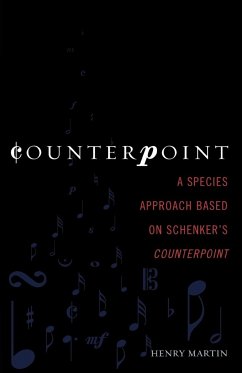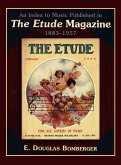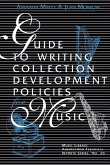- Broschiertes Buch
- Merkliste
- Auf die Merkliste
- Bewerten Bewerten
- Teilen
- Produkt teilen
- Produkterinnerung
- Produkterinnerung
Counterpoint helps music theory and music composition students improve their musicianship by examining the voice leading that underlies Western tonal music. It proceeds by developing species counterpoint in the tradition of Johann Joseph Fux and his famous Gradus ad Parnassum (1725), but with attention to Heinrich Schenker's more in-depth study. For the sake of brevity, musical examples are available on the Scarecrow Press website, rather than within the book itself.
Andere Kunden interessierten sich auch für
![The Craft of Tonal Counterpoint The Craft of Tonal Counterpoint]() Thomas BenjaminThe Craft of Tonal Counterpoint108,99 €
Thomas BenjaminThe Craft of Tonal Counterpoint108,99 €![Counterpoint Counterpoint]() Knud JeppesenCounterpoint20,99 €
Knud JeppesenCounterpoint20,99 €![Samuel Coleridge-Taylor Samuel Coleridge-Taylor]() Jewel Taylor ThompsonSamuel Coleridge-Taylor91,99 €
Jewel Taylor ThompsonSamuel Coleridge-Taylor91,99 €![Index to Music Published in The Etude Magazine, 1883-1957 Index to Music Published in The Etude Magazine, 1883-1957]() Index to Music Published in The Etude Magazine, 1883-1957229,99 €
Index to Music Published in The Etude Magazine, 1883-1957229,99 €![Musical Composition Musical Composition]() Ellis B. KohsMusical Composition98,99 €
Ellis B. KohsMusical Composition98,99 €![British Organ Music of the Twentieth Century British Organ Music of the Twentieth Century]() Peter HardwickBritish Organ Music of the Twentieth Century119,99 €
Peter HardwickBritish Organ Music of the Twentieth Century119,99 €![Guide to Writing Collection Development Policies for Music Guide to Writing Collection Development Policies for Music]() Amanda MapleGuide to Writing Collection Development Policies for Music55,99 €
Amanda MapleGuide to Writing Collection Development Policies for Music55,99 €-
-
-
Counterpoint helps music theory and music composition students improve their musicianship by examining the voice leading that underlies Western tonal music. It proceeds by developing species counterpoint in the tradition of Johann Joseph Fux and his famous Gradus ad Parnassum (1725), but with attention to Heinrich Schenker's more in-depth study. For the sake of brevity, musical examples are available on the Scarecrow Press website, rather than within the book itself.
Produktdetails
- Produktdetails
- Verlag: Scarecrow Press
- Seitenzahl: 148
- Erscheinungstermin: 4. Januar 2005
- Englisch
- Abmessung: 216mm x 140mm x 8mm
- Gewicht: 196g
- ISBN-13: 9780810854093
- ISBN-10: 0810854090
- Artikelnr.: 22222603
- Herstellerkennzeichnung
- Libri GmbH
- Europaallee 1
- 36244 Bad Hersfeld
- gpsr@libri.de
- Verlag: Scarecrow Press
- Seitenzahl: 148
- Erscheinungstermin: 4. Januar 2005
- Englisch
- Abmessung: 216mm x 140mm x 8mm
- Gewicht: 196g
- ISBN-13: 9780810854093
- ISBN-10: 0810854090
- Artikelnr.: 22222603
- Herstellerkennzeichnung
- Libri GmbH
- Europaallee 1
- 36244 Bad Hersfeld
- gpsr@libri.de
Henry Martin, born in Windsor, UK, brings a wealth of international experience and scientific knowledge to his writing. His journey has taken him across continents, living and working in diverse locations, including Britain, South Africa, Belgium, and several other countries in Africa, Europe, and the Middle East. With a Higher National Certificate in Chemistry and a background in veterinary medicine, Henry's career has spanned from laboratory work to managing a K9 security company. His professional path later led him into the world of computers, where he became a qualified Novell and Microsoft computer engineer. Henry's martial arts background in Aikido and Judo adds authenticity to the action scenes in his writing. His debut novel, "Sanctuary in Shadows", draws from his rich tapestry of experiences, blending scientific intrigue with pulse-pounding suspense. Now retired from his technical career, Henry has focused on writing. His first short story was published in Trembling with Fear magazine, marking the beginning of his literary journey. Henry views writing as creating a movie using only words, bringing vivid scenes to life for his readers. A private individual by nature, Henry prefers to let his work speak for itself. He resides in Belgium, where he crafts stories to challenge and entertain his readers.
Part 1 Preface
Part 2 Part One: Two-Part Counterpoint
Chapter 3 1 Exercise Writing and the Cantus Firmus
Chapter 4 2 Two-Part First Species (Note Against Note)
Chapter 5 3 Two-Part Second Species (Two Notes Against One)
Chapter 6 4 Two-Part Third Species (Four Notes Against One)
Chapter 7 5 Two-Part Fourth Species (Syncopation)
Chapter 8 6 Two-Part Fifth Species (Mixed Counterpoint)
Part 9 Part Two: Three-Part Counterpoint
Chapter 10 7 Three-Part First Species
Chapter 11 8 Three-Part Second Species
Chapter 12 9 Combined Counterpoint of the Second Species
Chapter 13 10 Three-Part Third Species
Chapter 14 11 Combined Counterpoint of the Second and Third Species
Chapter 15 12 Three-Part Fourth Species
Chapter 16 13 Three-Part Mixed Species
Chapter 17 14 Combined Species Incorporating Syncopation
Chapter 18 15 Combined Species with the Mixed Species; Imitation
Part 19 Part Three: Free Composition
Chapter 20 16 Modulation (Cadences to New Key Centers)
Chapter 21 17 Two-Part Free Counterpoint to the First Cadence
Chapter 22 18 More on Imitation; First Piece
Chapter 23 19 Invertible Counterpoint (Octave)
Chapter 24 20 More on Invertible Counterpoint
Part 25 Appendices
Chapter 26 1 Four-Part First Species
Chapter 27 2 Four-Part Simple Species (Second, Third, Fourth, Mixed)
Chapter 28 3 Five-, Six-, Seven-, and Eight-Part Counterpoint
Chapter 29 4 Four-Part Combined Counterpoints
Chapter 30 5 Three- or Four-Part Kyrie; Stretto
Part 31 Bibliography
Part 32 Index
Part 33 About the Author
Part 2 Part One: Two-Part Counterpoint
Chapter 3 1 Exercise Writing and the Cantus Firmus
Chapter 4 2 Two-Part First Species (Note Against Note)
Chapter 5 3 Two-Part Second Species (Two Notes Against One)
Chapter 6 4 Two-Part Third Species (Four Notes Against One)
Chapter 7 5 Two-Part Fourth Species (Syncopation)
Chapter 8 6 Two-Part Fifth Species (Mixed Counterpoint)
Part 9 Part Two: Three-Part Counterpoint
Chapter 10 7 Three-Part First Species
Chapter 11 8 Three-Part Second Species
Chapter 12 9 Combined Counterpoint of the Second Species
Chapter 13 10 Three-Part Third Species
Chapter 14 11 Combined Counterpoint of the Second and Third Species
Chapter 15 12 Three-Part Fourth Species
Chapter 16 13 Three-Part Mixed Species
Chapter 17 14 Combined Species Incorporating Syncopation
Chapter 18 15 Combined Species with the Mixed Species; Imitation
Part 19 Part Three: Free Composition
Chapter 20 16 Modulation (Cadences to New Key Centers)
Chapter 21 17 Two-Part Free Counterpoint to the First Cadence
Chapter 22 18 More on Imitation; First Piece
Chapter 23 19 Invertible Counterpoint (Octave)
Chapter 24 20 More on Invertible Counterpoint
Part 25 Appendices
Chapter 26 1 Four-Part First Species
Chapter 27 2 Four-Part Simple Species (Second, Third, Fourth, Mixed)
Chapter 28 3 Five-, Six-, Seven-, and Eight-Part Counterpoint
Chapter 29 4 Four-Part Combined Counterpoints
Chapter 30 5 Three- or Four-Part Kyrie; Stretto
Part 31 Bibliography
Part 32 Index
Part 33 About the Author
Part 1 Preface
Part 2 Part One: Two-Part Counterpoint
Chapter 3 1 Exercise Writing and the Cantus Firmus
Chapter 4 2 Two-Part First Species (Note Against Note)
Chapter 5 3 Two-Part Second Species (Two Notes Against One)
Chapter 6 4 Two-Part Third Species (Four Notes Against One)
Chapter 7 5 Two-Part Fourth Species (Syncopation)
Chapter 8 6 Two-Part Fifth Species (Mixed Counterpoint)
Part 9 Part Two: Three-Part Counterpoint
Chapter 10 7 Three-Part First Species
Chapter 11 8 Three-Part Second Species
Chapter 12 9 Combined Counterpoint of the Second Species
Chapter 13 10 Three-Part Third Species
Chapter 14 11 Combined Counterpoint of the Second and Third Species
Chapter 15 12 Three-Part Fourth Species
Chapter 16 13 Three-Part Mixed Species
Chapter 17 14 Combined Species Incorporating Syncopation
Chapter 18 15 Combined Species with the Mixed Species; Imitation
Part 19 Part Three: Free Composition
Chapter 20 16 Modulation (Cadences to New Key Centers)
Chapter 21 17 Two-Part Free Counterpoint to the First Cadence
Chapter 22 18 More on Imitation; First Piece
Chapter 23 19 Invertible Counterpoint (Octave)
Chapter 24 20 More on Invertible Counterpoint
Part 25 Appendices
Chapter 26 1 Four-Part First Species
Chapter 27 2 Four-Part Simple Species (Second, Third, Fourth, Mixed)
Chapter 28 3 Five-, Six-, Seven-, and Eight-Part Counterpoint
Chapter 29 4 Four-Part Combined Counterpoints
Chapter 30 5 Three- or Four-Part Kyrie; Stretto
Part 31 Bibliography
Part 32 Index
Part 33 About the Author
Part 2 Part One: Two-Part Counterpoint
Chapter 3 1 Exercise Writing and the Cantus Firmus
Chapter 4 2 Two-Part First Species (Note Against Note)
Chapter 5 3 Two-Part Second Species (Two Notes Against One)
Chapter 6 4 Two-Part Third Species (Four Notes Against One)
Chapter 7 5 Two-Part Fourth Species (Syncopation)
Chapter 8 6 Two-Part Fifth Species (Mixed Counterpoint)
Part 9 Part Two: Three-Part Counterpoint
Chapter 10 7 Three-Part First Species
Chapter 11 8 Three-Part Second Species
Chapter 12 9 Combined Counterpoint of the Second Species
Chapter 13 10 Three-Part Third Species
Chapter 14 11 Combined Counterpoint of the Second and Third Species
Chapter 15 12 Three-Part Fourth Species
Chapter 16 13 Three-Part Mixed Species
Chapter 17 14 Combined Species Incorporating Syncopation
Chapter 18 15 Combined Species with the Mixed Species; Imitation
Part 19 Part Three: Free Composition
Chapter 20 16 Modulation (Cadences to New Key Centers)
Chapter 21 17 Two-Part Free Counterpoint to the First Cadence
Chapter 22 18 More on Imitation; First Piece
Chapter 23 19 Invertible Counterpoint (Octave)
Chapter 24 20 More on Invertible Counterpoint
Part 25 Appendices
Chapter 26 1 Four-Part First Species
Chapter 27 2 Four-Part Simple Species (Second, Third, Fourth, Mixed)
Chapter 28 3 Five-, Six-, Seven-, and Eight-Part Counterpoint
Chapter 29 4 Four-Part Combined Counterpoints
Chapter 30 5 Three- or Four-Part Kyrie; Stretto
Part 31 Bibliography
Part 32 Index
Part 33 About the Author









